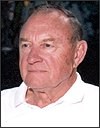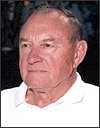Japanese torpedoes sank the heavy cruiser on July 30, 1945, about halfway between Guam and the Philippines. The Indianapolis had just delivered the components for the first atomic bomb dropped on Japan.
Mr. Redmayne had joined the 1,196-person crew as chief engineer six weeks before and was headed back to his room shortly after midnight when he felt the torpedoes hit.
The first destroyed the ship's bow. The second hit on the starboard side near a fuel tank, causing a massive explosion that ripped the ship apart.
Using his arms to shield his eyes from flames, Mr. Redmayne climbed to the main deck to await orders. On deck, he realized he was walking on water.
"He just walked into the ocean," said Gertrude Redmayne, his wife of 61 years.
Some 300 sailors went down with the ship. Another 900 escaped into the water in the 12 minutes before it sank. Most succumbed to shark attacks, dehydration, lack of food or injuries.
"They prayed a lot and talked a lot and tried to figure out what their chances of survival were," Gertrude Redmayne said.
Mr. Redmayne, who was pulled unconscious from the water by a Navy rescue ship, emerged with severe burns on his hands and sores from the salt water.
He was awarded the Purple Heart and the Bronze Star.
The scars remained all his life, said Gertrude Redmayne, but Mr. Redmayne didn't shy away from returning to sea. He stayed in the Navy for two more decades before retiring in 1968.
He served for two years as a professor of naval science at Harvard University and as commander of the Eaton, a destroyer stationed in Norfolk, Va.
Mr. Redmayne attended only a few USS Indianapolis reunions and stopped going altogether some 30 years ago.
"Dick was not one to reminisce," said Gertrude Redmayne. "It broke him up, answering people's questions about their sons or their husbands."
Mr. Redmayne was born in Westwood, Mass., and graduated from the Massachusetts Maritime Academy in 1937. He traveled to Africa with the Merchant Marine before joining the Navy in 1940.
He and Gertrude met on a blind date in Hilo, Hawaii, where her father, an Army officer, was stationed. The two married in January 1942, a month after the Japanese attack on Pearl Harbor.
In 1998, the couple moved to a retirement community in North Seattle from their home in Maine to be near their three sons. In recent years, Mr. Redmayne suffered from dementia. He died at home of complications from pneumonia.
Mr. Redmayne is survived by his wife, Gertrude Redmayne of Seattle; his sons, Burt, Graham and Peter, all of Seattle; daughter, Judy Redmayne of Newton, Mass.; and four grandchildren.
The family plans a private memorial service.
Japanese torpedoes sank the heavy cruiser on July 30, 1945, about halfway between Guam and the Philippines. The Indianapolis had just delivered the components for the first atomic bomb dropped on Japan.
Mr. Redmayne had joined the 1,196-person crew as chief engineer six weeks before and was headed back to his room shortly after midnight when he felt the torpedoes hit.
The first destroyed the ship's bow. The second hit on the starboard side near a fuel tank, causing a massive explosion that ripped the ship apart.
Using his arms to shield his eyes from flames, Mr. Redmayne climbed to the main deck to await orders. On deck, he realized he was walking on water.
"He just walked into the ocean," said Gertrude Redmayne, his wife of 61 years.
Some 300 sailors went down with the ship. Another 900 escaped into the water in the 12 minutes before it sank. Most succumbed to shark attacks, dehydration, lack of food or injuries.
"They prayed a lot and talked a lot and tried to figure out what their chances of survival were," Gertrude Redmayne said.
Mr. Redmayne, who was pulled unconscious from the water by a Navy rescue ship, emerged with severe burns on his hands and sores from the salt water.
He was awarded the Purple Heart and the Bronze Star.
The scars remained all his life, said Gertrude Redmayne, but Mr. Redmayne didn't shy away from returning to sea. He stayed in the Navy for two more decades before retiring in 1968.
He served for two years as a professor of naval science at Harvard University and as commander of the Eaton, a destroyer stationed in Norfolk, Va.
Mr. Redmayne attended only a few USS Indianapolis reunions and stopped going altogether some 30 years ago.
"Dick was not one to reminisce," said Gertrude Redmayne. "It broke him up, answering people's questions about their sons or their husbands."
Mr. Redmayne was born in Westwood, Mass., and graduated from the Massachusetts Maritime Academy in 1937. He traveled to Africa with the Merchant Marine before joining the Navy in 1940.
He and Gertrude met on a blind date in Hilo, Hawaii, where her father, an Army officer, was stationed. The two married in January 1942, a month after the Japanese attack on Pearl Harbor.
In 1998, the couple moved to a retirement community in North Seattle from their home in Maine to be near their three sons. In recent years, Mr. Redmayne suffered from dementia. He died at home of complications from pneumonia.
Mr. Redmayne is survived by his wife, Gertrude Redmayne of Seattle; his sons, Burt, Graham and Peter, all of Seattle; daughter, Judy Redmayne of Newton, Mass.; and four grandchildren.
The family plans a private memorial service.
Family Members
Sponsored by Ancestry
Advertisement
Explore more
Sponsored by Ancestry
Advertisement






